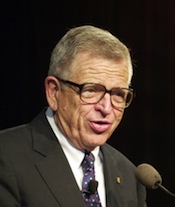 Faith & Science
Faith & Science
 Intelligent Design
Intelligent Design
What Made Chuck Colson Great
 I only met Chuck Colson once, several years ago when he spoke in the Seattle area. Before the speech a mutual friend brought me up to where Colson and his wife, Patty, were sitting in the front row. He was old and it was noisy in the auditorium, so to be heard I had to get down on one knee in front of him. The gesture, imposed by acoustics, felt oddly appropriate.
I only met Chuck Colson once, several years ago when he spoke in the Seattle area. Before the speech a mutual friend brought me up to where Colson and his wife, Patty, were sitting in the front row. He was old and it was noisy in the auditorium, so to be heard I had to get down on one knee in front of him. The gesture, imposed by acoustics, felt oddly appropriate.
It wasn’t a long conversation and I can only say that there was something palpably special about the impression he gave. It was not only that he had read and expressed appreciation for an article I had just written in the alumni magazine of our shared college alma mater. There was something so benign, twinkling, wise, warm, and sweet in his crinkly face that struck me unexpectedly and with a power that’s hard to explain. You don’t meet many people of whom that is true.
Bruce Chapman noted yesterday that when it came to intelligent design and the work we do at Discovery Institute, Colson got it — in a way, I would add, that many Christians and Jews frustratingly do not. I’ve just been looking back at the texts of some of the BreakPoint broadcasts he did on the theme of ID — whether giving his well informed view, as a lawyer, of the Dover decision, or knowledgeably summing up recent books on ID, from William Dembski to Michael Behe to Stephen Meyer, and reviewing Signature in the Cell in some detail.
Of course, you’re not going to escape criticism for that, even in death and even from conservatives. In an appreciation published in the Wall Street Journal, political scientist John J. Dilulio Jr. writes a lovely tribute to Colson’s influence on Dilulio’s own thoughts, how “in the late 1990s Colson was among those who softened and spiritualized my views on crime.”
Promoting the concept of “restorative justice,” Colson godfathered into being several conservative coalitions that are now making real headway in reducing prison populations and changing penal codes in many states. For example, as documented by the Texas-based Right on Crime organization, in recent years the Lone Star State has cut crime rates while reducing its adult prison population by thousands, and the number of juveniles behind bars by more than 50%, by repealing draconian sentencing laws and increasing support for community-based corrections.
Disappointingly, Dilulio gives it as an aside that Colson’s advocacy of ID slightly mars the record of his life: “He insisted that hard science supported ‘intelligent design’ even when leading evangelical Christian scientists, like Francis Collins, former head of the international human genome project, counseled otherwise.”
Dilulio was among the writers I edited and admired when I worked with him as an editor at National Review. I truly cannot understand how a thoughtful and independent guy like that, at the mention of ID, can write a sentence that thoughtless. He seems to be saying that because Francis Collins is an evangelical Christian and a famous scientist, Colson ought to have let Collins do his thinking for him.
Perhaps one reason Colson was not overly impressed by Francis Collins is that he knew Collins to be a leading government exponent of embryonic stem-cell research. Maybe another reason is that Colson had read enough of the actual content of ID proponents, and written on the subject himself, to know that Collins spoke on the subject in a misinformed and therefore misleading way.
It’s surprising, too, that Dilulio misses the thematic connection between Colson’s humane activism through Prison Fellowship and his stance on ID. Only because men and women give evidence of a unique purpose, bearing the image of a designing intelligence that transcends us, does it really make sense to view crime in the humane and spiritual way that Colson advocated and that Dilulio came to embrace.
Colson brought a real and precious wisdom to bear, whether the subject was science or public policy, and saw these issues whole. He didn’t need Francis Collins to think for him.
We are strangely short of great men in the present generation, and he was one. They seem to be dying off without being replaced. Who can name a younger man or woman prominent in public life today who looks to be on the way to achieving equally venerable stature? I’m afraid — literally, I am afraid — that I can’t. Why not kneel?
Photo credit: Colson Center.
